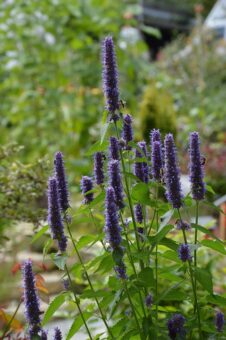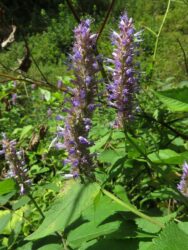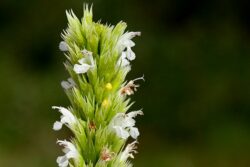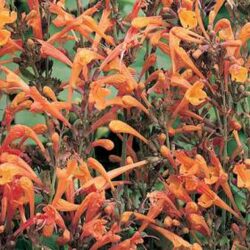In this article, we will discover how to grow the perennial Agastache in Containers. It is a plant that is native to the plains and prairies of North America and so you can imagine is a tough plant. Let us get something straight, although it has the common name of hyssop on its name, it is only related to true hyssops and mint very distantly. After all, they are members of the Lamiaceae family (the mint family).

It is a tender perennial that has aromatic green leaves and on top of these colourful spikes of blue or purple flowers appear. These are common colours for older cultivars, but the new ones come in a more wide range of colours including pink, white, red and orange. It is not only a good plant to look at but the leaves can be dried and used to make a refreshing cup of tea.
As said earlier it is a tender perennial, where in areas where they get no frosts, it can be grown as a reliable perennial, but in other areas, this is not recommended. In these areas, it is best to grow and treat the plants as annuals. You can try to save the plant by either moving your container inside a greenhouse or by covering it with thick horticultural fleece. There is a hardy variety called ‘Blue Fortune’ that is hardy to -15 degrees Celsius once established, but then yet again it is still a risk.
It is well worth growing as it is an attractive plant to bees and other beneficial insects.
GROWING AGASTACHE IN CONTAINERS
You can either grow Agastache from shop-bought plants or you can raise them from seed.
GROWING AGASTACHE FROM SEEDS

It is best to sow seeds under glass in February and March. Fill a seed tray with a good quality seed sowing compost and water it well, allowing the excess to drain away. Sprinkle the seeds thinly on the surface of the compost and then add a 6mm layer of sieved compost on top. Cover with a propagator lid and place it in a warm spot.
Once the seedlings have started to emerge and they are big enough to handle, you can prick them out individually into 7.5cm pots full of multipurpose compost. Allow the plant to grow on and in Mid-may you can start to harden off before planting outside in late May/Early June.
At this stage, garden-ready plants and home reared seed-grown plants can be treated the same way.
GROWING AGASTACHE IN CONTAINERS
First, choose a container that will suit and be in balance with the plant in question. Whatever you choose make sure it has plenty of drainage holes to allow excess water to drain away. To the bottom of the container, add a 1cm layer of gravel to improve drainage even further. On top of this, mix 20% by volume of horticultural grit with 80% by volume of multipurpose compost to form a free-draining growing media.
Dig a hole in the compost that is slightly greater than the size of the root ball it came in the original container. Place the plant in so that the top of the root ball is at the same level as the top surface of the compost. Backfill with the growing media ensuring that no gaps remain (use more compost if you have to). Firm the plant in and water well.
THEY ARE SUN LOVERS
Full sun is a must for Agastaches, as too much shade will stop them from flowering too well. Although the plants can grow up to 1m in height producing flowering spikes in late summer, they will not need much in the way of staking. This is because the stems tend to be strong but if you want a straighter plant then you can individually stake each stem. This is advised if you live in a windy area otherwise the stems can be damaged.

Until the plant is well-established, you will need to water frequently to help the plant develop. Once the plant has reached a level of maturity, it will tolerate drought very well. Best to water your containers when 5cm below the top of the surface of the compost feels dry to the touch. Water well until it flows out of the drainage holes.
You may find that a handful of slow-release fertilizer at planting, but no more. This is because too much fertilizer will cause the plant to flower less and produce leaves instead of flowers. It will also cause the plants to become floppy, so in terms of fertilizer, less is more.
You will need to remove spent blooms as they appear. You can trim them as needed so that it will prevent the plant from self-seeding everywhere. This should not be too much of a problem in container growing species. To prevent this remove spent blooms before the seed heads turn brown and open and drop seeds to the ground.
If you are lucky enough to have a warm climate then you can treat it as a perennial, where 1/3 of the old growth can be removed to stimulate new growth in spring.
PESTS AND DISEASES

Agastaches tend not to suffer much in the way of pests and diseases. During dry weather, you may notice the webbing of spider mites, causing the leaves to curl and turn yellow.
You can use water to splash the spider mites off but if it is too much of a problem. You can use a suitable insecticide/miticide to deal with them. All you need to do is make sure it is suitable for the mites in question.
It is important to have free-flowing growing media, as too much water can cause fungal infections and rotting of the roots and crown. The only way to prevent this as highlighted in this article is to create a free-draining growing media.
If you are willing to transplant self-seeded plants into containers the following year, then do so, but do not expect the plants to have the same colour as the mother plant.
VARIETIES TO GROW
The following varieties to grow include:
Agastache ‘Blue Bog’ has tall spikes of violet-blue flowers. It is hardy to -5 degrees Celsius and will need some winter protection.
Agastache ‘Tango’ is a compact variety only growing to 40cm high with orange blooms from summer to autumn.
Agastache ‘Purple Haze’ produces tall, dense spikes of dark purple flowers.
Agastache pallidiflora ‘Rose Mint’ produces pink-purple flowers that appear light green leaves
Agastache aurantiaca ‘Apricot Spirit’ produces tubular bloom of apricot-orange flowers.
Agastache ‘Astello Indigo’ with spikes of blue flowers that appear during summer.
Agastache rugosa ‘Golden Jubilee’ has golden-green leaves with small spikes of lavender-blue flowers.
Agastache ‘Cana’ produces spikes of flowers of pale pink.
Agastache mexicana is a tenderer of all the species grown in the UK that produces pale pink flowers. Best grown as an annual in the UK. produces deep blue flowering spikes in summer and early autumn.
Agastache foeniculum has silvery–green leaves that produce spikes of blue flowers that appear all summer long.
CONCLUSIONS
In this article, we have discussed how to grow the wonderfully colourful and useful perennial of Agastache in containers. They are easy to grow, easy to look after as long as you are prepared to grow them year on year.
They are not only attractive to look at but they are great for wildlife pollinators and they can be used in the kitchen as well.
If you have any questions or comments that you wish to make on growing Agastache in containers, please do so in the comment box below.
Happy Agastache growing.

What size pot,.I have try small plant right now, 3 in 2 in pots.
Hi
I would pot them on in stages until reaching a 20cm diameter pot.
Thank you
Antonio